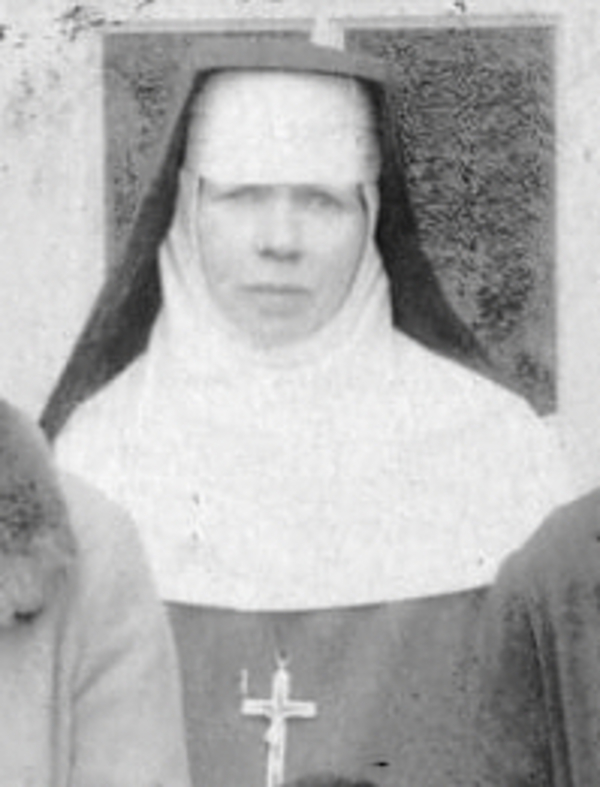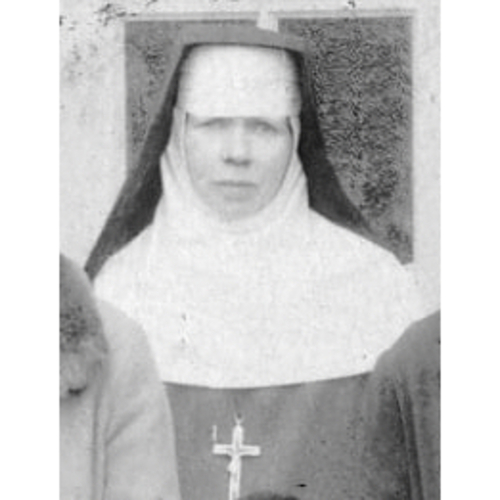
Source: Link
O’Melia, Kathleen FANNY, named Sister Mary of the Angels in 1914 and Sister Mary Stella in 1926, Church of England lay missionary, teacher, Roman Catholic lay missionary, and religious of the Franciscan Sisters of the Atonement; b. 28 Dec. 1869 in Walpole St Andrew, England, youngest daughter of Frederick O’Melia, a Church of England clergyman, and Elizabeth Lowthian; d. 5 Sept. 1939 in Vancouver.
When Kathleen O’Melia was young, her father became rector of the parish in North Stoke, Somerset, and she spent most of her childhood there. She and her two sisters were educated at home. In the late 1880s and early 1890s she attended extramural lectures, sat for university exams at Oxford and Cambridge, and received certificates in numerous subjects. She taught school for a few years in various parts of England and then returned home to care for her elderly parents. Reading about the lives of the saints fostered her interest in Roman Catholicism.
After the deaths of her mother in 1899 and her father in 1901, O’Melia felt called to the missions of British Columbia. In March 1902 she went to Vancouver to work in the Church of England’s St James’ parish, where St Luke’s Home, a hospital established 14 years earlier by Frances Dalrymple Redmond [Byron] and the Reverend Henry Glynne Fiennes-Clinton, had become a centre of social activism. O’Melia soon began to teach English and undertake social work for the Japanese immigrant community in the Little Tokyo district located mainly around Powell Street. She studied Japanese and quickly became fluent. With the aid of Fiennes-Clinton, rector of St James’, and the women’s auxiliary of the parish, she set up a mission to the Japanese. Fiennes-Clinton provided High Church services with O’Melia as translator. The attitude of her group and of the Methodist-sponsored Woman’s Missionary Society contrasted with the racist hostility prevalent in British Columbian society at the time. By 1911 O’Melia and the congregation of the mission had raised funds to buy a building. They hoped to have a Japanese convert trained as a minister.
After Fiennes-Clinton died in January 1912, O’Melia discovered that the mortgage on the Japanese mission building had been held in his name in trust for the Church of England’s synod. Its leaders wanted to place an Englishman at the head of the mission. There seemed little likelihood that such a clergyman would share O’Melia’s Anglo-Catholic beliefs and High Church practices, so in August 1912 she asked Roman Catholic archbishop Neil McNeil to accept her as a convert. He agreed and arranged for her to teach at a boys’ school in New Westminster during the period when she was receiving instruction. By December, O’Melia had returned to Powell Street to establish a Roman Catholic mission to the Japanese with the archbishop’s encouragement. With the aid of a few women volunteers, she taught English and catechism and undertook social work, helping Japanese immigrants settle in Vancouver and access child and health care. She and two assistants became members of the Third Order of St Francis, an association of laypersons who lived according to the spirit of the Franciscans and often wore their habit. She took the name Sister Mary of the Angels in 1914. Archbishop McNeil found few priests to assign to the mission, and his successor, Timothy Casey, was no more successful. The Oblates of Mary Immaculate, particularly Julien-Augustin Bédard, provided religious services until Franciscans arrived from Montreal in 1922. Japanese-speaking priests en route to Asia also spent time at the mission.
To ensure the continuity of the mission, Sister Mary of the Angels sought the aid of a religious congregation. The Franciscan Sisters of the Atonement from Garrison, N.Y., themselves converts to Roman Catholicism, agreed in 1926 that she could enter their congregation and that they would send members to British Columbia. At the Graymoor novitiate in Garrison, Sister Mary of the Angels became Sister Mary Stella. She returned to Vancouver in 1928 to teach English and to help the mission’s new superior expand services to include a kindergarten and a health clinic. In 1931 a new mission was established in Steveston. The following year the Franciscan Friars of the Atonement in the United States sent priests to these two missions.
By the time Sister Mary Stella died in 1939, one of her former pupils, Peter Baptist Katsuno, was preparing for ordination and a posting at the mission. Although it had made only a few hundred converts since 1912, the organization had become an important educational and service centre for the Japanese Canadian community. Among its members, Sister Mary Stella, known as O’Melia San, was legendary.
According to historian Vincent Joseph McNally, the Roman Catholic Church in British Columbia never made “a significant effort” to “evangelize Asians.” He describes both the Japanese mission and the Chinese mission, begun in 1921 by the Montreal-based Missionary Sisters of the Immaculate Conception, as being of “minor importance” since they were “put in the sole care of religious women.” O’Melia’s efforts deserve appreciation. She pioneered both Anglican and Roman Catholic missions to the Japanese in Vancouver in the face of many obstacles: a racist society, patriarchal church leaders, competition from Buddhists, Methodists, and members of other religions, and shortages of staff and funds. She obtained little help from the Catholic authorities. The Vancouver archdiocese was preoccupied by differences between its hierarchy and the Oblate congregation, its serious financial difficulties, and its lack of personnel. Most sisterhoods in the province were French Canadian in origin and had their own priorities. O’Melia’s achievement in establishing the mission, which subsequently brought in both Canadian and American Franciscans to assist the archdiocese, is remarkable. So, also, is the continuing regard of Japanese Canadians for Sister Mary Stella, their O’Melia San.
Writing as Sister Mary Stella, Kathleen Fanny O’Melia is the author of “The life and work of Sister Mary Stella O’Melia, (died September 5, 1939) (as written by herself under obedience in 1934),” Candle (Garrison, N.Y.), 17 (1940); 18 (1941); 19 (1942); 20 (1943).
Arch. of the Roman Catholic Archdiocese of Toronto, MN (McNeil papers), AH02.12., O’Melia to McNeil, 12 Feb. 1913. Roman Catholic Archdiocese of Vancouver Arch., “1926–1976: 50 years in British Columbia, Franciscan Sisters of the Atonement”; Franciscan Sisters of Atonement (), corr. and reports; St Paul’s Parish, corr., 1926. Univ. of B.C. Library, Rare Books and Special Coll. (Vancouver), Japanese Canadian Hist. Preservation Committee fonds, Tape recordings – SP ser., SP 23:13 (Sister Antoinette McDonough interview, 20 June 1983). Ken Adachi, The enemy that never was: a history of the Japanese Canadians (Toronto, 1976). Anglican Church of Can., Diocese of New Westminster, Synod, Journal (Vancouver), 1909–11 (report on the Japanese mission; copies held at the Anglican Diocese of New Westminster Arch.). Father Boniface [H. J. Heidmeier], Pioneering in the west: memories of his life and experiences in the west with the Franciscans ([Vancouver], 1957). Jacqueline Gresko, “O’Melia San and the Catholic Japanese mission, Vancouver, B.C.,” CCHA, Hist. Studies, 75 (2009): 83–99; Traditions of faith and service: archdiocese of Vancouver, 1908–2008 (Vancouver, 2008). Lyndon Grove, Pacific pilgrims (Vancouver, 1979). Alphonsus Hoban, “The Society of the Atonement as a missionary society: the western Canadian experience,” STA Heritage ([n.p.]), 1 (May 1984), no.6: 5. C. L. James, “An opportunity for service: women of the Anglican mission to the Japanese in Canada, 1903–1957” (ma thesis, Univ. of B.C., Vancouver, 1990). Norman Knowles, “A selective dependence: Vancouver’s Japanese community and Church of England missions, 1903–1942,” Canadian Church Hist. Soc., Journal (Toronto), 38 (1996): 53–76. J. B. Lissarrague, “Avec les Japonais dans le far-west,” Soc. des Missions étrangères, Annales (Paris), no.131 (janvier–février 1920): 360–77 (available at gallica.bnf.fr/ark:/12148/bpt6k9738311n). V. J. McNally, The Lord’s distant vineyard: a history of the Oblates and the Catholic community in British Columbia (Edmonton, 2000). F. A. Peake, The Anglican Church in British Columbia (Vancouver, 1959). Deborah Rink, Spirited women: a history of Catholic sisters in British Columbia (Vancouver, 2000). Roman Catholic Archdiocese of Vancouver, Monthly Bull. (Vancouver), June, August 1920; September, November 1921. P. E. Roy, “An ambiguous relationship: Anglicans and the Japanese in British Columbia, 1902–1949,” BC Studies (Vancouver), no.192 (winter 2016/17): 105–24; The oriental question: consolidating a white man’s province, 1914–41 (Vancouver, 2003). Toyo Takata, Nikkei legacy: the story of Japanese Canadians from settlement to today (Toronto, 1983). Huguette Turcotte, “Hospitals for Chinese in Canada: Montreal (1918) and Vancouver (1921),” CCHA, Hist. Studies, 70 (2004): 131–42. Mitsuo Yesaki, Sutebusuton: a Japanese village on the British Columbia coast (Vancouver, 2003).
Cite This Article
Jacqueline Gresko, “O’MELIA, KATHLEEN FANNY, named Sister Mary of the Angels and Sister Mary Stella,” in Dictionary of Canadian Biography, vol. 16, University of Toronto/Université Laval, 2003–, accessed January 1, 2026, https://www.biographi.ca/en/bio/o_melia_kathleen_fanny_16E.html.
The citation above shows the format for footnotes and endnotes according to the Chicago manual of style (16th edition). Information to be used in other citation formats:
| Permalink: | https://www.biographi.ca/en/bio/o_melia_kathleen_fanny_16E.html |
| Author of Article: | Jacqueline Gresko |
| Title of Article: | O’MELIA, KATHLEEN FANNY, named Sister Mary of the Angels and Sister Mary Stella |
| Publication Name: | Dictionary of Canadian Biography, vol. 16 |
| Publisher: | University of Toronto/Université Laval |
| Year of publication: | 2022 |
| Year of revision: | 2022 |
| Access Date: | January 1, 2026 |



